The height of the chimney determines the safety for you and your loved ones. If during the operation of gas boiler equipment the chimney plays the role of a flue channel, with low-temperature combustion products, then no compromises are allowed for solid fuel boilers, stoves and fireplaces.
The fact is that if the parameters of the chimney or channel are incorrectly calculated, there is a risk of serious poisoning by combustion products, or even a fire can be provoked by unburned fractions or fragments of ignited soot.
Ventilation to allow excess water vapor to drain to the outside. Smoke systems with internal ceramic channels. Which chimney to use for gas condensate boilers? For gas condensate boilers, flue systems with a closed combustion chamber, commonly referred to as air exhaust systems, should be used. They are built from a flue gas duct and an air duct required for combustion. This solution improves the energy efficiency of the boiler as the outside air heats up to counteract the flow in the direction of flow.
How to correctly calculate the parameters of the chimney
The following rules should be followed:
- The height of the chimney is not the only parameter that affects the performance and safety of the heating system, with a gas or solid fuel boiler as a heating device. Designing a chimney begins with determining the operating parameters of the heating system. This means that the complex for calculating the boiler house should take into account these factors as well. By this time, the owner of the premises must decide on the type of fuel used (gas, pellets, firewood or peat), decide with the help of a specialist on the heat output of the boiler, decide on the types of radiators or convectors. There are a lot of questions, however, the omission of some moment can adversely affect the performance of the entire heating system. For example, many novice builders of their own homes are mistaken that all chimneys are the same. This is not true. Brick chimney is good for heating solid fuel, for example, wood, but it is not intended for space heating with a gas boiler.
- With regard to the operating parameters of the boilers, the height of the chimney can also affect the final heating efficiency. Do not forget about the cross section of the pipe - the diameter affects the minimum and maximum volume of passing combustion products, provided with natural draft.
- The process of calculating the chimney of a fireplace or solid fuel boiler may require additional calculations and measurements. This is due to the use of one smoke channel by several devices in the boiler room at the same time. Self-activity can lead either to unforeseen parameters of heating operation or even to sad consequences.
- There is no chimney system that could be universal for any type of fuel, boiler equipment and used as a standard solution. In this regard, the most difficulties arise for developers and owners of private houses and cottages.
Smoke systems with ceramic internal air ducts. Confirmation of their fulfillment is a proper classification, which is the source of information about the requirements for a given chimney. Only chimney systems that meet the above requirements may be used in conjunction with gas condensate boilers. What are the cross sections chimneys most commonly used in single-family homes? Is there a universal cross section for gas and solid fuel boilers?
Each time, sections of the chimneys are selected based on the technical requirements of the boiler and taking into account the height of the chimney. For most gas or oil boilers optimum diameter is 14 cm, for the lower chimneys the diameter increases. Therefore, the choice of a universal diameter is not possible. You must approach a boiler with a closed combustion chamber. For such boilers, chimneys of a different design are required.
What should be the chimney
The best and optimal shape for a chimney is the shape of a cylinder. With a square section, uneven heating can be observed in the corners of the channel, which will lead to inevitable destruction as a result of thermal expansion. In addition, uneven heating over the entire surface causes a process of natural thrust, which begins to move in a spiral, rushing up.
The choice of chimney is free. What are the ways to repair an old chimney? One of the most popular ways to repair an old chimney is to place a steel insert inside an existing brick chimney. Please note, however, that the cartridge used must match the type of fuel used and the power of the boiler.
At what height should the exhaust tee be installed? What is the distance of the chimney from combustible elements? This distance is determined from the inner surface of the cartridge. Attention! Please note that national requirements are mandatory and comply with European harmonized standards.
For these reasons, the shape that will minimally oppose the natural movement of the gases is the cylinder. rectangular shape will inevitably lead to the appearance of resistance due to turbulence and this will cause additional loss of burning and soot. For stoves and fireplaces, this effect can be regarded positively, since turbulence contributes to the additional removal of heat from the exhaust.
The harmonized European standards, on the basis of which chimney systems are declared compliant, also define the distance of the chimney from combustible components. It is given in millimeters, always in the company of the soot fire resistance class and, contrary to national regulations, this distance is determined from the outside of the chimney.
Compliance with the standard does not meet national regulations! What is the height of the chimney above the roof? The height of the chimney above the roof depends primarily on. In cases where no specific values are given, a static calculation is recommended. In particular, doors and inspection in chimneys are necessary. To ensure proper manufacture of chimneys and the ability to remove thicker dirt from the bottom of the chimney.
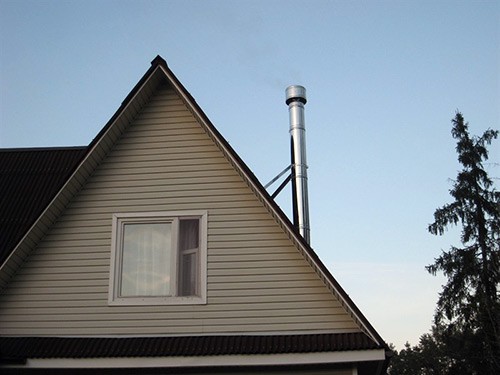
If your boiler room is equipped for a solid fuel or gas boiler of a modern design, it is better not to experiment and use cylindrical pipes. Important! Modern boilers they mainly work according to an economical algorithm, which means that the boiler should warm up as quickly as possible and switch to a more gentle mode. To do this, it will be necessary not only to burn a lot of fuel, but also to ensure the supply of oxygen and the removal of combustion products.
Proper design, construction and termination of the chimney, especially in relation to the flue section above the roof of the building. When building or upgrading heating and ventilation systems in buildings, investors are increasingly opting for modern solutions. These decisions are made based on the building's safety and energy efficiency potential. An important element of the installation of heating and ventilation is the choice of a system responsible for the discharge of exhaust gases outside the building. When the gases are merged by gravity, a smooth flue system is needed.
Regarding the diameter of the chimney, this means that by narrowing the exhaust cross section, you will not be able to achieve savings and effective work boiler equipment. In practice, in an attempt to save money, the owners do not buy and install pipes that are calculated according to the technical design.
What should be the height
The height of the chimney above the roof requires special attention, since it is there that the products of combustion pass from a closed and safe environment to the outside. If this height is insufficient for the gases to be safely cooled and mixed with air, a hazardous situation of combustion poisoning or even a fire may result.
A chimney is a structure that is an integral part of a building. Regardless of the type of chimney used in a building for safety reasons, it is important that they are properly constructed and maintained. Each chimney must be built in accordance with the rules, standards and regulations. Assumptions to be fulfilled by chimneys in buildings.
Appropriate hygiene and health and environmental protection. Noise and vibration protection. Energy savings and adequate thermal insulation of partitions. Smoke structure materials must be non-flammable and have sufficient fire resistance.
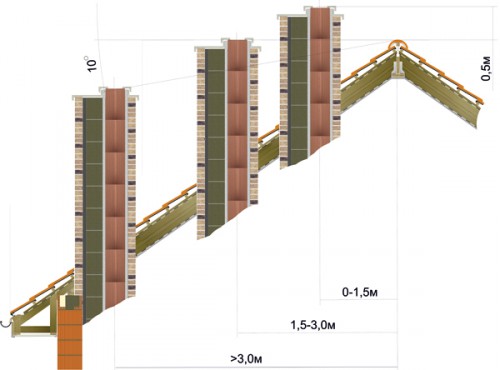
Another issue that deserves attention is the physics of the natural draft process. The fact is that being in the chimney pipe, heavy air tends to rise up, forming a physical phenomenon of draft. The more warm air, the more thrust is created. The volume inside the pipe is affected by two indicators: internal volume and height.
The inner surface of the chimney must minimize flow resistance and be resistant to the damaging effects of exhaust gases. The chimney is designed to ensure tightness. All chimney lining materials must be approved for construction use in terms of: sanitary, pressure, temperature, humidity and fire resistance during operation and during failure.
The cross section of the chimney in the light must be adapted to the requirements of the connected device. The cross section of the chimney must be limited along its entire length. The use of collective exhaust, chimney and ventilation pipes is not allowed. Chimneys must provide access to periodic cleaning and control during operation.
Here it is necessary to achieve the indicator of the "golden mean". Natural draft can lead to a significant increase in heat loss, since the exhaust will not have time to carry out heat exchange with the internal volume. This is very critical for solid fuel fireplaces and stoves.
Let's say you have a chimney, about 4 meters high. Based on the foregoing, the higher the chimney, the greater the draft, but it turns out that there is back side this process is cooling. A tall pipe will cool faster and create an air lock with heavy cool gas that will interfere with draft. The second negative phenomenon caused by the abuse of the height of the chimney will be condensation.
In the event of a change in the function of the chimney, it must be adjusted to the new conditions in terms of cross-section and protection against the damaging effects of gases discharged into the chimney. Chimneys must be of such height that the string in them is sufficient to release gases from supported devices.
The outlet of the chimney must follow the roof to an appropriate height. For flat roofs of irregular shape with a slope of no more than 12 °, steep roofs with an angle of more than 12 ° and a combustible coating - at least 0.60 m above the level of the ridge. For steep roofs with a pitch angle of more than 12° and non-combustible, cable outlets must be at least 0.30 m from the roof surface and at least 1.0 m from the surface.
Specialists calculate the height and cross-section of chimneys using special software products that are built on the basis of thermodynamic data.
Height above roof
The height of the end of the chimney from the ridge or roof must fit into the pre-calculated regulations. If it is at a distance of 1.5 meters from the ridge, its height is allowed from 0.5 meters. The farther from the vertical line of the ridge, the higher the end of the chimney should be located accordingly. At a distance of 3 meters, the chimney should be almost completely aligned with the maximum height of the ridge.
When chimneys are located next to an obstruction, recessed roofs must have chimney outlets. Piping and end of chimneys. Ventilation ducts must run from the inlet to the outlet of the chimney. The outlet openings of the ventilation ducts must be transverse.
Emergency fire lines should work like chimneys. The chimneys must always pass through the roof of the building to a height that will allow the wind to blow safely, which can cause draft distortion. The top of the chimney must be covered with a concrete cover.
The chimney glass is a technical solution that maintains natural consistency. Chimney bases help eliminate the cause of chimney failure by increasing draft. However, it should be remembered that the chimney cover does not provide, but only supports the draft of the chimney. It is worth noting that the chimney must be sufficiently insulated along its entire length. In practice, unsaturated chimney bases are installed. This can cause disturbances in the chimney draft due to large changes in temperature parameters in the wire at the height of the installed unsaturated base.

Do not neglect such an important stage of housing construction as the miscalculation of the chimney. Entrust the correct calculations to specialists, and you will receive the optimal parameters for height, diameter and type of material used for chimneys for various boilers. Beneath these figures lie the complex laws of aerodynamics, thermodynamics and materials science.
Increasingly, the risks associated with chimney inhalation by animals are becoming more common. Birds nesting in chimneys pose a serious threat to the construction of wires and their users. In extreme cases, they can cause fatal blows, so bird guards must be used to protect chimneys. Bird protection devices are often unfriendly to environment and cause injury to animals. Below is an example of a well-made animal chimney guard.
Rice. 2 Chimneys are out of place relative to each other. Installation of chimneys on the roof. When designing chimneys, it is important to remember that they are correctly positioned on the roof of the building. New chimney designs should be positioned so that their adjacent crowns do not obstruct each other. Chimneys above the roof of the building must end at the same height. Where it is possible to control chimneys in the middle of a building instead of an external wall, it is advisable to use it. Then the chimney will have more energy.
An essential condition for the efficient and safe operation of heating equipment is the correct calculation and installation of the chimney. Its construction must be carried out in full compliance with all technological standards by experienced craftsmen with sufficient qualifications.
When using steel as a material for the manufacture of a chimney, it must be ensured that its thickness is at least one millimeter. Special attention must be given to chimneys connected to boilers operating on liquid or gaseous fuels - they must be made of corrosion-resistant steel grades.
The location of the channels in the middle of the building allows you to recover part of the heat that is discharged through the chimney with flue gas. This is the result of heat convection through the chimney wall into the building. You shouldn't make chimneys in the trunk. Also remember to keep in touch so people can move around to do maintenance and inspection work on the chimneys.
The location of the chimneys on the roof has a big impact on the aesthetics of the facility. Chimneys should be designed in accordance with applicable architectural principles, for example, chimneys in a homestead should be located near the ridge and symmetrical about the axes, but in a house of different plans it can be arranged more freely. It doesn't look good when one chimney starts through the eaves and the other next to the ridge.
Of great importance is how high the chimney should be, because the traction force largely depends on this (read also: ""). If the chimney passes from the outside of the building or through an unheated room, then it must be additionally insulated, otherwise problems with draft cannot be avoided.
Chimney installation features
When building a chimney, it must be borne in mind that it must meet a number of specific requirements:
This article provides basic information about the design of over-roof chimneys. In practice, there are often problems associated with the operation of chimneys, caused by poor performance of the chimney at the end of it. These problems not only cause heating and ventilation equipment to malfunction, but can also cause a fire or carbon monoxide leak in a building. The completion of the chimneys above the roof of the building directly affects the improvement of the safety of the building, its energy efficiency and correct work heating and ventilation equipment.
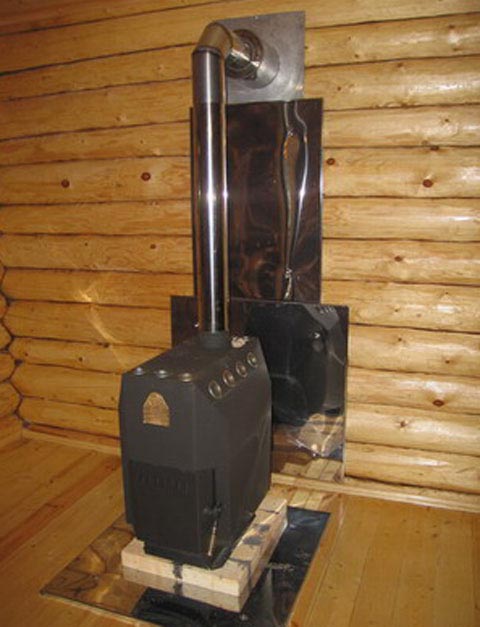
The height of the chimney above the roof may vary depending on specific circumstances and conditions:
In the event that the chimney rises above the roof by more than one and a half meters, or it cannot be securely fixed to the supporting elements, it is necessary to use special extension clamps or a structure that performs the function of a mast.
Technical requirements and acceptance tests. A properly selected cable must provide sufficient smoke velocity to keep it warm before exiting the chimney. Their cross section is adapted to the predicted amount of exhaust gases, the effective height of the cable, the number and size of the heating device, and the temperature difference between the exhaust and air. materials which are made. When calculating the height of the chimney or chimney outlet, we must take into account the type of roofing. For fire safety reasons, the chimney must be located at a height of more than 0.6 m from the ridge for flat and steep roofs covered with flammable material.
The chimney elements are mounted from the bottom up, starting from the heater, while the inner one is inserted into the previous one, and the outer one is put on it. For effective sealing, you should use a product whose operating temperature is at least 1000 degrees.
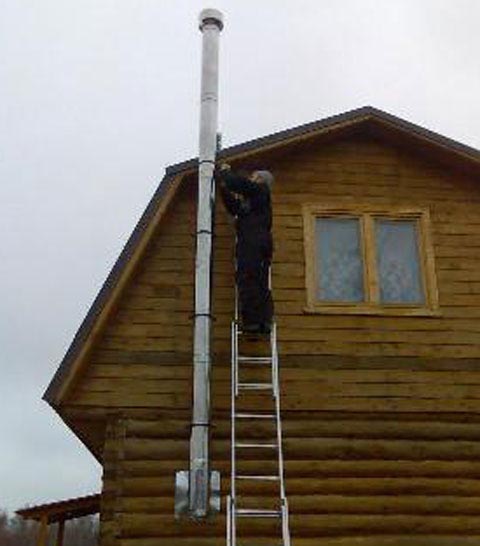
How far from combustible elements of the chimney structure?
In the case of a steep roof covered with non-combustible material, the chimney outlet must be at least 0.3 m above the roof slope and a distance of 1 m measured horizontally from the chimney outlet to the roof surface. The distance of chimneys from combustible building elements is regulated by the Building Code. If the elements are not closed, keep a distance of 30 cm between them and the chimney. This distance seems unreasonable in the case of a much safer and fire-resistant insulation system - system chimneys.
During the installation of smoke channels, they should not be allowed to come into contact with electrical wiring, gas pipe and other communications. When passing the chimney through the roof and the ceiling system, it is necessary to leave an indent from the crate and other elements that would ensure proper fire safety. In order to prevent ignition of structures adjacent to the chimney made of combustible materials, either also leave indents or make sections of non-combustible materials. The dimensions of these sections when combustible materials are used in the building structure should be 500 millimeters, for protected structures - 380 millimeters. Designs are considered protected, sewn up with metal sheets on 8 mm asbestos cardboard, or covered with a 25 mm layer of plaster on a metal mesh.
Spark arrester on the chimney - features of use ").
Checking the chimney and further operation
After the final decision has been made on how high the chimney should be, and all work on its installation has been completed, a control firebox should be performed to assess the tightness of the joints and check whether nearby structures made of combustible materials heat up. When first used, slight smoke and a peculiar smell may occur due to the evaporation of oil and sealant residues.
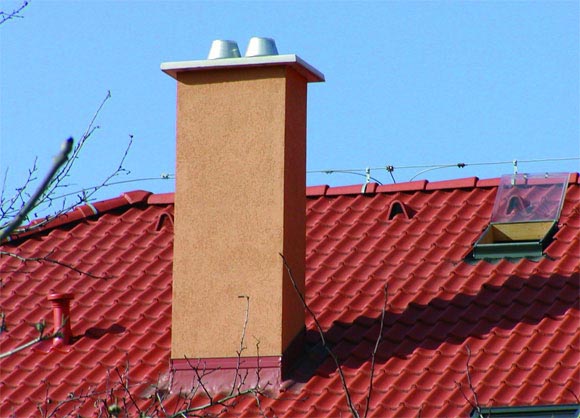
When using a modular chimney system, avoid:
- drying shoes, clothes and other items on its elements;
- operation in a manner not provided for by the manual;
- removal of soot deposits by burning;
- the use of chlorine and its compounds;
- placement near the chimney of objects and means prone to ignition;
- use of construction debris, household chemicals, paints and varnishes and coal as fuel.
In order to ensure the normal functioning of the chimney and to prevent the accumulation of tar and soot, which can subsequently ignite, it is necessary to clean the chimney at least twice during the heating season.
Proper installation and subsequent operation of the chimney is the key not only to the efficient operation of heating equipment, but also to minimizing the risk of fire hazards.








